The presence of Distributed Generation (DG) has significant effect on distribution network such as efficiency, reliability, power flow, voltage profile, protection, and stability. It brings challenges to traditional distribution network especially if the DG is installed both in Medium Voltage (MV) and Low Voltage (LV) distribution network. The distribution company continue to face severe technical and business challenges in the new market environment. Spiegel [1] state that DG has a significant impact on the balancing energy demand. Governments are supporting the connection of small/medium size generators directly to the distribution network, but the consequent growing number of energy producers poses several technical issues. A review of the current state of the art reveals that a number of studies have addressed the grid integration issues related to the renewable energy sources. For the planning and operation of a distribution network, it is then important to estimate the maximum installable generation according to the limits imposed by the power quality standards [2], as well as to study the optimum design conditions for facility capacity, including economic efficiency analysis based on energy production, initial investment cost and operating cost. Verzijlbergh et al. [3] identified a number of key challenges, for new modelling and decision making tools that can capture the complex interdependencies of a Renewable Energy Sources (RES) based energy system. In Olowu et al. [4], identified Photovoltaic (PV) penetration problems like reverse power flow, voltage fluctuations, power quality issues, dynamic stability, big data challenges and suggested future solutions. It is suggested that the existing solutions need further development. So, for the problem of reverse power flow it is necessary to reduce the choice of point of interconnection. Another challenge discussed in [5]–[7] is about difficulties that face the integration of DG like wind energy and solar energy concerning power quality requirements that must be achieved to get this connection successfully. Heaslip et al. [8] suggested a comprehensive understanding of how barriers can be transformed into enablers, supports for the successful development of sustainable energy communities at local level in Europe. Based on the transformation of the energy supply system into a system with a high share of RES, the integration of fluctuating electricity generation becomes crucial. Renewable energy production is dependent on the load and the weather. Consequently, the utilization of existing flexibility potentials has got to increase steadily. Smart Grid Task Force [9] identifies the actions which are required in order to enable European consumers to offer their flexibility in the energy markets and benefit from it. Distribution System Operators (DSO) should have the opportunity to use flexibility services where this provides a benefit to the network and hence to the consumer. Seefried et al. [10] presented a semi-structured interview methodology used in order to gather knowledge on the barriers and enables to sustainable energy communities development.
The high levels of DG integration have many undesired consequences on the grid, such as over voltage and over current. Pecas Lopes et al. [11] state that these negative effects normally happen because most of the distribution networks currently in service were not designed to handle generation at the distribution level, distribution grids were designed to distribute centrally generated electrical power that is delivered by the utility. Even though the conventional design of the grid has numerous advantages, this design philosophy limits the ability of grids to handle large amounts of DG. Jenkins et al. [12] state that some very specific features of embedded generation, often connected into relatively weak networks, and not usually dispatched by network operator has meant that existing techniques and practices have had to be reviewed and updated to take these features into account. In [13]–[15] optimal placement and sizing techniques are suggested. Australian Energy Market Operator conducted research for Technical Integration of Distributed Energy Resources. The report [16] suggests that without network reinforcement, there would be limits to the amount of Distributed Energy Resources (DER) that could be connected. Amongst the important factors that influence the role of DG within centralized systems in [17], [18] have been identified the potential to be integrated into the existing infrastructure and the regulatory factors that affect the emergence and operation of DG. The static and transient impact of large-scale DGs integrated with the distribution network has discussed in [19], [20]. The static voltage stability has shown that a reasonable choice of DG’s power grid position will help to improve the stability of the system, meantime the induction motors may cause the instability of DGs and grid. The asset maintenance management in distribution system is discussed in Jalili et al. [21] while in Ioannou et al. [22] was conducted the literature review about the need to measure the associated risk and uncertainty as the number of DGs increases.
Most of the previously published research gives suggestions on how renewable resources should be implemented and the consequences they may have on the distribution network. On the other hand, the development of these new capacities was not associated with the development of the respective area distribution network. These publications do not address the consequences of incorrect implementation of renewable. On the other hand, the previously published research mainly examine the wind and PV type of renewable and a very few of them analyze small and medium size Hydro Power Plant (HPP) [23], [24]. This paper aims to further elaborate the above‐mentioned issues analysing the impact of the small and medium size HPPs connected to the distribution network.
The paper is structured as follows: firstly the methodology used is outlined. Next the Electric Distribution System Operator (EDSO) and context to the research is described. Following this, the results are including a discussion in relation of study and some conclusions.
The main focus of this study is to verify the impact in the network operation of the small and medium size HPPs connected to distribution network. The result of the study have been obtained and further compared analysing of different load/generation scenarios, connection points according to the level of the voltage at Albanian distribution network in the subject area/region.
The penetration of small and medium size private HPPs on the distribution system, mainly run of river types, distributed as well in the 35, 20, 10 and 6 kV network, has changed the characteristics of the distribution system and has impacted in different way the technical parameters, referring to the connection point and their installed capacities.
The analysis will address issues such as technical constrains and financial impacts related with the penetration of DG into the distribution system. The topic problems are focused on:
Allowed limits of voltage;
Level of power losses;
Reverse power flow to the transmission grid;
Deficiency in the transformer and transmission capacities;
Negative financial impacts of the EDSO and generation companies.
In order to see the impact of DG on the level of power losses, the Line Loss Reduction Index (LLRI) is calculated:
(1)
where LLW/DG and LLWo/DG, respectively, are the total line losses in scenarios with and without DG.
Transformer Loss Reduction Index (TLRI) is calculated according:
(2)
where TLW/DG and TLWo/DG, respectively, are the total transformer losses in scenarios with and without DG.
Another important problem is reliability analysis of power distribution system. The DG affect the reliability of the power system especially when a large number of DG units are in operation at once. The main performance indicators of the distribution network are:
System Average Interruption Frequency Index (SAIFI);
System Average Interruption Duration Index (SAIDI).
The value of SAIFI and SAIDI has to compare with standard value according to IEEE Standard 1366-2012 [25].
SAIFI is measured in units of interruptions per customer:
(3)
It is usually measured over the course of a year, and according to IEEE Standard 1366-2012, the median value for North American utilities is approximately 1.10 interruptions per customer.
SAIDI is measured in units of time, often minutes or hours:
(4)
It is usually measured over the course of a year, and according to IEEE Standard 1366-2012, the median value for North American utilities is approximately 1.50 hours.
The analysis of the distribution network will be simulated using NEPLAN software. The load profiles of main customers and HPPs connected to distribution network are taken into account.
To suggest strict rules to be followed in respect of connection point of HPPs into the distribution network, in order to guarantee a reliable and secured operation of the network and to contribute to the improvement of the performance indicators of the distribution network.
EDSO was legally established in Albania in 2007, followed by privatization process which resulted unsuccessful ones and since 2014 EDSO has the status of public company 100% owned by state. EDSO manages 102 substations with 35/10/6 kV and about 1,130 km of 35 kV lines that stretches across the country.
The EDSO assets like 35/10/6 kV substations as well as the 35 kV lines connecting these substations have a 40-42 years utilization period and consequently have high aging and depreciation. The overloaded work regime in which they worked has led EDSO to face difficulties in managing the network, which are reflected in the quality of customer supply: the number of outages, their duration as well as the level of losses.
The new social-economical developments and the free moving of the population, change significantly the electricity consumption in Albania [26]. The rapid increase of the power demand and the reduction of available capital have resulted in a need for improvement in production and use of electricity, the increasing of the international connections and exchanges, and more extensive justification of new system facilities. The first approach to overcome this challenges it was the increase of the international connections and exchanges [27]. Albania is actually a net importer country of electrical energy.
The electricity demand has not only been increased extremely, but the significant changes have been in its structure as well. In [Figure 1] is shown the structures of electricity consumption in three different periods. The character of load is changed from industrial to residential/commercial. These kinds of loads consume small reactive power. So, the load is more active power.
The structures of electricity consumption in three different periods
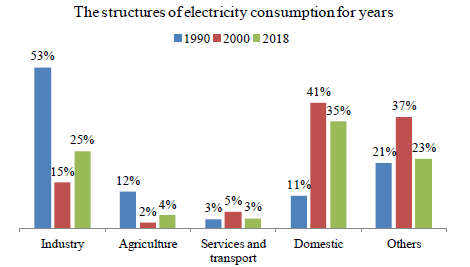
The approach of satisfying the country needs with electrical energy through import is not a feasible alternative from view of the security of power supply and from economic point of view, taking into account that the import prices are not stable and are subject of fluctuation. The changes on the legislation framework [28], [29] for the power sector, adaptation of the new market model and the public and private investments done during last decade on generation, transmission and distribution system changed drastically the situation of the power supply. Since 2002, the Albanian Government has considered the energy sector as a strategic sector and began to support the construction of new private or concessionary HPPs [30]. Albania has a high potential in hydropower. The total HPPs installed capacity is 1,878 MW with the energy production that varied according the hydrological year from 2.864 TWh on year 2007 to 8.552 TWh on year 2018 (with 755.2MW increase of installed capacity) [31], and average annual energy production of 4.2 TWh, while Albanian National Agency on Natural Resources has estimated potential for HPPs capacity installation is about 4,500 MW with average annual energy production of 16 TWh [32]. So, only 42% of hydropower potential is utilized. Energy policies encourage the use of renewable energies such as wind, hydro, solar, biomass, etc. As a result of the still unexploited hydro capacities, almost all plants are built as HPPs, and a large proportion of those with installed capacity less than 15 MW. These power capacities are connected to the distribution network, turning the distribution network into an active network. The implemented projects of small and medium size HPPs through private investment partnership or concessions schemes have had a very positive impact in energy production and reduction of the import in Albania. Despite the significant impact in generation, they have had also an impact on transmission system and distribution system, consequently this new system state has to be tackled to identify the system constraints. Therefore, it is necessary to study the ability of a grid to handle HPPs penetration without compromising the quality of the power being delivered [33]. Design, construction, implementation projects of hydro power plants and their connection to the distribution network is a process that have been growing up rapidly in the last two decades and according the studies [34] is going to be the same trend also in the near future.
In previous work [35], it was discussed the result of a study in respect of the impact in the network operation of the small and medium size HPPs connected to 110 kV transmission network, and it was proposed realistic solution in respect of the voltage profile, protection scheme and flexibility on the grid operation side during outages, in order to maintain the stability of the system. Incentive policies applied in the last decade in order to comply with the strategic objectives for the evaluation and development of hydro production capacities in Albania through private investment, partnership or concessions schemes have been also discussed.
In this work, was analysed and assessed critically the technical issues and developments affecting the penetration into the distribution network of small and medium size HPPs in Albania. Different load scenarios have been analysed for different specific areas within the region according the deployment of HPPs, topology of the network, availability of the lines, possible failures and outages of lines and take also into account the future penetration of hydropower plants already in phase of implementation.
A large number of the hydropower plants are connected in the Albanian distribution network in the last decade. In [Figure 2] are represented the number of small and medium HPPs connected to the distribution network according to the level of the voltages during period 2011-2018. They are concentrated mainly in the South East area, whereas the hydropower potential is still yet to be developed.
Number of HPPs connected to the distribution network during 2011-2018
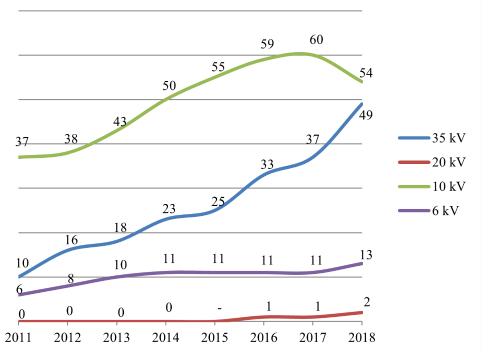
In [Table 1] is listed the installed capacity of HPPs connected to distribution network during the period 2011-2018 [36]. In [Table 2] is listed the monthly energy export/injected in MWh from EDSO to TSO (reverse power flow) network for the period 2014-2018. [Table 3] shows the hosting capacity of high voltage side of the substations administrated by EDSO expressed as a ratio of the installed power generation of the HPPs and the installed power transformer of the substations administered by EDSO.
Installed capacity of HPPs connected to distribution network (2011-2018)
| Year | 2011 | 2012 | 2013 | 2014 | 2015 | 2016 | 2017 | 2018 |
| Installed capacity [MW] | 75 | 101 | 102 | 171 | 208 | 217 | 228 | 240 |
The electric energy consumed in the electric distribution network is concentrated in the regions of Tirana-Durres (about 50% of the total energy consumption), while the major part of the new generation capacities are installed in rural areas with low consumption of energy (about 17% of total consumption).
Most of the HPPs connected to the distribution grid are run-of-river, i.e., they do not create large water reserves and do not require the construction of large dams or reservoirs so due to the non-energy storage there is a weak correlation with grid load request, especially during night when there is low energy demand and when power generated by HPPs may be at its peak favoured by weather conditions as water flows. Under these conditions occurs the reverse power flow to Transmission System Operation (TSO).
Monthly energy export in MWh from EDSO to TSO network (2014-2018)
| Year | 2013 | 2014 | 2015 | 2016 | 2017 | 2018 |
| Energy injected in EDSO [MWh] | 351,683 | 392,488 | 444,405 | 661,796 | 471,558 | 743,083 |
| Energy exported from EDSO to TSO [MWh] | 54,256 | 55,532 | 98,049 | 162,833 | 122,687 | 269,528 |
| Energy exported/Energy injected [%] | 15 | 14 | 22 | 25 | 26 | 36 |
Penetration index of HPPs as a ratio of the installed power generation of the HPPs and the installed power transformer of the substations
| High voltage unit | PmaksTR: Installed power of transformers [MW] | PmaksGen: Generated peak power [MW] | PmaksGen/PmaksTR ratio [%] |
| Southeast unit | 623 | 109 | 17 |
| Southwest unit | 682 | 45 | 7 |
| Centre unit | 1,199 | 15 | 1 |
| North unit | 587 | 81 | 14 |
| Total | 3,091 | 249 | 8 |
Meantime, the major part of the new generation capacities are installed in remote rural areas, where the distribution network, despite the periodical maintenance faces an increased number of outages, deficiency in the transformer and transmission capacities to welcome the injection of generation of the new HPPs.
Distribution network continuously is closed to the limit of normal operation due to the fact of high penetration of energy generated from the new HPPs. Such constrains includes technical constrains referring to the allowed limit of the level of the voltage to be maintained, level of losses of loads, specific requests of Transmission System Operator (TSO), etc.
Referring to the requirements for the connection of new HPPs or new sources, mainly PV to the distribution network, the total capacity of HPPs connected to the distribution grid will reach around 800 MW or about 26% of the installed capacity of transformer 3,091 MW, meantime 54% of the peak power of 1,480 MW is reached at 31 December 2018 at 6 PM.
The main performance indicators of the distribution network SAIFI and SAIDI are calculated for overall distribution network for the period 2015-2018 and given in the [Table 4]. The value of SAIFI and SAIDI can be categorized as not reliable than the SAIFI and SAIDI value standard according to IEEE Standard 1366-2012.
The process of distribution network modernization initiated by EDSO management supported from the Albanian Government and the development of foreign projects has made distribution network to perform better every year. However, the levels of performance indicators for MV are still very high compared with European countries.
Despite the efforts to improve the performance of the distribution network through investment supported from Albanian Government and through the development of foreign projects, the state of the network is still very high in terms of the level of SAIFI for MV (1-2 customers per year) in European countries.
The performance indicators (2015-2018)
| Period | SAIFI times/customer/year | SAIDI hours/customer/year |
| January-December 2018 | 34.02 | 65.18 |
| January-December 2017 | 35.6 | 74.4 |
| January-December 2016 | 43.2 | 97.1 |
| January-December 2015 | 49.1 | 122 |
The impact of small and medium size HPPs in the losses in the distribution networks is depended from the injected power and connection point in the network. Furthermore, power generation units with a very weak correlation with the network loads, such as HPPs run off the river types, may have a negative impact in the network losses, especially during the night when the load demand is in minimum and when the generated energy is very high supported from the weather conditions such as inflow of the water (reverse power flow).
In order to evaluate any system constrains or issues related with distribution network operation, in the identified areas with high penetration of small and medium size HPPs, have been performed the analysis by considering three typical scenarios studies as follows:
Scenario without the connection in the distribution network of small and medium size of HPPs;
Scenario with actual HPPs connected in the distribution network;
Scenario with the expected HPPs to be connected in the distribution network.
All scenarios have been analysed also for different specific areas within the region depending in the deployment of HPPs, topography of the network, availability of the lines, possible failures and outages of lines, etc. Simulations have been performed for all cases and the results of load flow, voltage levels and losses have been compared. The results of the analysis performed are discussed in following.
Firstly, the Elbasan distribution region with the largest share of electricity generated by the HPPs connected to their local distribution networks is analysed. In [Figure 3] is presented the voltage value on 35 kV bus of the Elbasan distribution region for scenario without/with actual HPPs connected in the distribution network. In the scenario with actual HPPs connected in the distribution network (red line) can be seen that HPPs improve the voltage level. Meantime, during the night low demand, the voltage level is above the maximum allowed value. Increasing the level of voltage in these areas has resulted in damage to equipment in substations.
The voltage value on 35 kV bus for scenario without/with actual HPPs connected in the distribution network
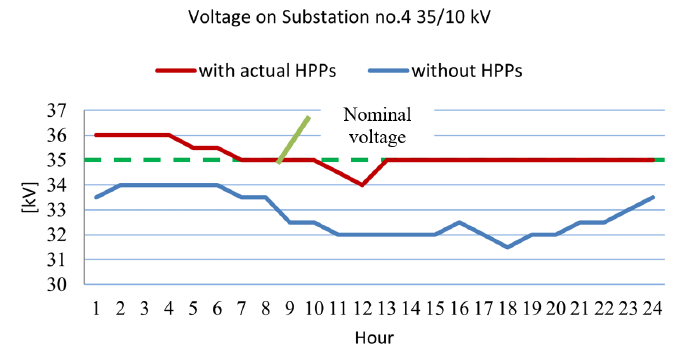
In [Figure 4] are presented the voltages value on 35 kV buses for scenario with actual HPPs connected in the distribution network.
The results of the analysis indicates that in the actual scenario (no.2) the voltages are increased, because of very high penetration and injection of the energy generated in the 35 kV network and very low consumption during the night hours.
In the presence of HPPs, the 35 kV line L-30-75 which withstands the active power flow generated by the HPPs connected to the 35 kV substation bus bars, is overloaded at 71%. Meanwhile, the reverse power flow to the transmission network is considerable. In the expected scenario it accounts about 87% of the total input power in the network.
In the [Table 5] are shown the results of the analysis performed for three scenarios. If LLRI < 1, DG has contributed to the reduction of system losses, while if LLRI > 1, DG has contributed to the increase in system losses (dP). The same for TLRI index.
The voltages value on 35 kV buses for scenario with actual HPPs connected in the distribution network
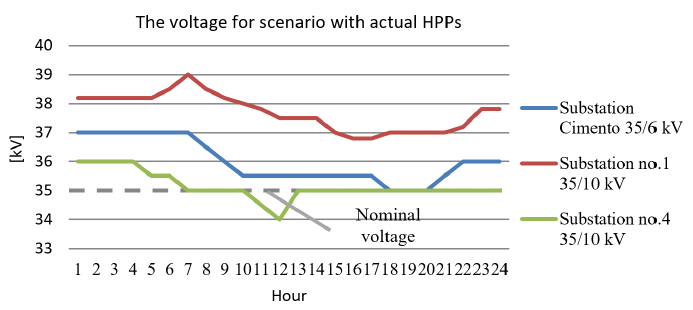
Summary results of the load flow balance for each scenarios
| Nr. | Scenario | Penetration [%] | PHPPs/PLoad | dP [%] | LLRI |
| 1 | Without HPPs | 0 | 0 | 2.07 | 1.0 |
| 2 | Actual | 50 | 6 | 24.18 | 15.1 |
| 3 | Expected | 100 | 10 | 25.57 | 16.3 |
The voltages values for the expected HPPs scenario to be connected in the distribution network are presented in [Figure 5]. The results of the analysis indicates that in the expected scenario (no.3) the voltages are increased compared with the base scenario, because of very high penetration and injection of the energy generated in the 35 kV network and very low consumption during the night hours.
The voltages value on 35 kV buses for scenario with HPPs expected to be connected in the distribution network
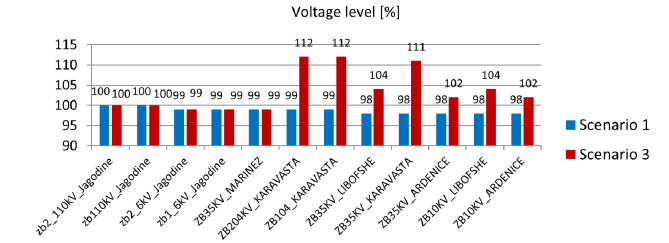
In [Figure 6] are shown the total active losses in kWh and in percentage for each scenario analysed. It can be seen that the active losses are increased compared with the base scenario, because of very high penetration and injection of the energy generated in the 35 kV network and very low consumption during the night hours. In the actual scenario, the losses accounts for 4.63% in other terms are 1.58% higher compare with the base scenario while in the expected scenario with HPPs that will be connected in the future the losses reach the value of 7.62%.
Summary results of the losses for each scenario
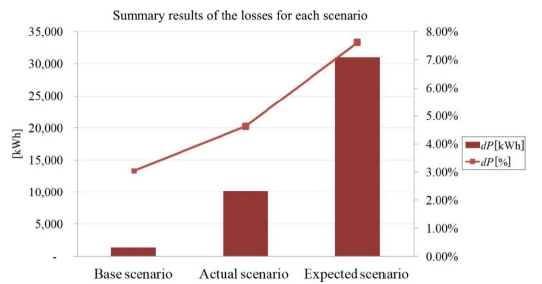
In order to complete the analysis performed, attention is also given to the financial impact aspects in the view of both generation companies and DSO.
As it was mentioned above, the distribution network is almost 40 years old, suffers from an increase number of failures and outages, increased repair time, especially in the rural areas where also the new HPPs are connected.
The Distribution Company is facing also, claims and penalty for liquidated damages for the generation companies connected to the distribution network referring to the obligation of the Contract for Transaction approved from Regulatory Body [37] [Albanian Energy Regulator Authority (ERE) Nr.101, 23.06.2016], in cases when the generated energy cannot be delivered due to physical constrains of the distribution network.
As it is stated in Çelo et al. [38], system state is characterized by equipment availability: unit generators, lines and transformers, by the load level at each bus bar according the voltage level and by all constrains related with hydroelectric plants and limited capacity on the transmission and distribution system. Station components failures that results in line outages are accounted for by an adjustment in the line failure rates. The indices obtained from the statistic analyse the historical data of the events occurred in the life of power system, specifically to the subject areas where distributed generators are connected and have been directly related to the reliability of supply as well as to the total value of unsupplied energy from the failure.
The unsupplied energy due to the failures and outages during 2017, accounts for almost 16,376,850.00 kWh or equivalent to EUR 1.4 million missing income to the generation companies due to not selling of such energy.
Furthermore, even in the best scenario, where the network is in good condition, but the power generated by HPPs exceeds sensitively the low energy demand occurs the reverse power flow to TSO. The exceeded amount of energy injected into the transmission network, increase also the additional costs for EDSO, which is obliged to pay the transmission fee tariff.
Calculation referring to the data of 2018 shows that EDSO has the total cost of the energy exported/injected to the TSO that accounts for EUR 20,308,257, while the yearly average rate of realized investments for EDSO is around EUR 40,000,000. Under such condition, i.e., a regulated tariff system and incentive policies that are in place in Albania in respect of the selling price of energy generated by HPPs connected to the distribution network, the cost of energy exported/injected to the transmission system accounts for 50% of total investments cost realized in one year in the distribution network managed and operated by EDSO.
Coming back to the third scenario and analysing all the requests for the connection point in the distribution network, for new hydro generation capacities expected to be developed in the subject areas in the nearest future, seems that it is almost impossible for the Distribution Company to comply with such requests without reinforcement of the network and new investments. The areas that need urgent intervention are rural areas, especially where the new HPPs are connected and the reliability indices of the energy are not reached, furthermore, the operation of the network is not a reliable and secured.
The analyse performed supports the necessity of reinforcement of the network and new investments in the specific area subject of analyse and emphasise the need of clear and strict rules to be followed in respect of connection point of HPPs into the distribution network, in order to guarantee a reliable and secured operation of the network and to contribute to the improvement of the performance indicators of the distribution network.
This paper presents the various challenges faced with the high penetration of small and medium HPPs in the distribution network of Albania. With the expected development of hydropower potential in the near future, this paper also took an extensive look at different future scenarios and their possible impacts in the distribution network.
The main focus of this paper was to verify the impact in the network operation of the small and medium size HPPs connected to 35, 10 and 6 kV distribution network and to point out sensitive areas where the investment are needed to be carried out. Different scenarios have been analysed also for different specific areas within the region depending on the deployment of HPPs, topology of the network, availability of the lines, possible failures and outages of lines, etc.
The results of the analysis performed indicates that the South-East area have been positively impacted from the deployment of HPPs, but referring to the topology of the network, the aged distribution network has created some problems and issues in respect of very high levels of the voltage in the substations during the minimum load consumption due to very high generation and low consumption, high level of the losses, etc.
Another issue to be addressed is the fact that the distribution network in some rural areas with very low consumption is initially designated as a distribution network, and now is used as a transmission network for the energy injected from the high penetration of HPPs in these areas, but with a very limited transmission capacities that do not support at all such concentration of new generation capacities.
It is important to prioritise the investment in the distribution and transmission network in order to guarantee a harmonization development of power sector and to support the penetration of hydropower potential capacities under the framework of liberalization of the generation activities and functionalization of a healthy competitive market.
The authors thank the editor and the anonymous reviewers, considering their comments and suggestions a valuable contribution in improving the final version of manuscript.
- ,
Impact of Renewable Energy Expansion to the Balancing Energy Demand of Differential Balancing Groups ,J. Sustain. Dev. Energy Water Environ. Syst , Vol. 6 (4),pp 784-799 , 2018, https://doi.org/https://doi.org/10.13044/j.sdewes.d6.0215 - , Hosting Capacity of Distribution Networks: Evaluation of the Network Congestion Risk Due to Distributed Generation, Proceedings of the 2015 International Conference on Clean Electrical Power (ICCEP), 2015
- ,
Institutional Challenges Caused by the Integration of Renewable Energy Sources in the European Electricity Sector ,Renewable and Sustainable Energy Reviews , Vol. 75 ,pp 660-667 , 2017, https://doi.org/https://doi.org/10.1016/j.rser.2016.11.039 - ,
Future Challenges and Mitigation Methods for High Photovoltaic Penetration: A Survey ,Energies , Vol. 11 (7),pp 1782 , 2018, https://doi.org/https://doi.org/10.3390/en11071782 - , Integrating Variable Renewable Energy: Challenges and Solutions, Technical Report, NREL/TP-6A20-60451, 2013
- ,
Challenges and Benefits of Integrating the Renewable Energy Technologies into the AC Power System Grid ,American Journal of Engineering Research , Vol. 6 ,pp 95-100 , 2017 - ,
hallenges, Causes, Impacts and Utilization of Renewable Energy Sources -Grid Integration ,International Journal of Engineering Research and Applications , Vol. 4 (3),pp 636-643 , 2014 - ,
Assessing Good-practice Frameworks for the Development of Sustainable Energy Communities in Europe: Lessons from Denmark and Ireland ,J. Sustain. Dev. Energy Water Environ. Syst , Vol. 4 (3),pp 307-319 , 2016, https://doi.org/https://doi.org/10.13044/j.sdewes.2016.04.0024 - , European Commission, EG3 Report: Regulatory Recommendations for the Deployment of Flexibility, 2015
- ,
Regional Analysis of Potentials of Flexibility Options in the Electricity System for the Study Regions Prignitz in Brandenburg and Anhalt-Bitterfeld-Wittenberg in Saxony-Anhalt ,J. Sustain. Dev. Energy Water Environ. Syst , Vol. 8 (1),pp 162-183 , 2020, https://doi.org/https://doi.org/10.13044/j.sdewes.d7.0277 - ,
Integrating Distributed Generation Into Electric Power Systems: A Review of Drivers, Challenges and Opportunities ,Electr. Power Syst. Res , Vol. 77 (9),pp 1189-1203 , 2007, https://doi.org/https://doi.org/10.1016/j.epsr.2006.08.016 - , , Embedded Generation, 2000
- ,
Optimal Placement of Non-Site Specific DG for Voltage Profile Improvement and Energy Savings in Radial Distribution Networks ,Power Engineering and Electrical Engineering , Vol. 12 (5),pp 392-406 , 2014, https://doi.org/https://doi.org/10.15598/aeee.v12i5.1080 - ,
Optimal Distributed Generator Allocation Method Considering Voltage Control Cost ,Sustainability , Vol. 8 (2),pp 1-20 , 2016, https://doi.org/https://doi.org/10.3390/su8020193 - ,
Optimal DG Location and Sizing for Minimum Active Power Loss in Radial Distribution System Using Firefly Algorithm ,International Journal of Energetica , Vol. 2 (1),pp 6-10 , 2017 - , Australian Energy Market Operator, 2019
- ,
A Review of the Role of Distributed Generation (DG) in Future Electricity Systems ,Energy , Vol. 163 ,pp 822-836 , 2018, https://doi.org/https://doi.org/10.1016/j.energy.2018.08.022 - ,
Challenges of PV Integration in Low-Voltage Secondary Networks ,IEEE Trans. Power Deliv , Vol. 32 (1),pp 525-535 , 2017, https://doi.org/https://doi.org/10.1109/TPWRD.2016.2556692 - ,
The Impact of Large-Scale Distributed Generation on Power Grid and Microgrids ,Renew. Energy , Vol. 62 ,pp 417-423 , 2014, https://doi.org/https://doi.org/10.1016/j.renene.2013.07.032 - ,
Integration of Renewable Energy Systems and Challenges for Dynamics, Control, and Automation of Electrical Power Systems ,Wiley Interdisciplinary Reviews: Energy and Environment , Vol. 8 (1), 2019, https://doi.org/https://doi.org/10.1002/wene.321 - , Risk-Based Asset Maintenance Management in Distribution System, 2011
- ,
Risk-Based Methods for Sustainable Energy System Planning: A Review ,Renewable and Sustainable Energy Reviews , Vol. 74 ,pp 602-615 , 2017, https://doi.org/https://doi.org/10.1016/j.rser.2017.02.082 - ,
Development of Small Versus Large Hydropower in Norway – Comparison of Environmental Impacts ,Energy Procedia , Vol. 20 ,pp 185-199 , 2012, https://doi.org/https://doi.org/10.1016/j.egypro.2012.03.019 - ,
Technical and Economic Perspective for Repowering of Micro Hydro Power Plants: A Case Study of an Early XX Century Power Plant ,Energy Procedia , Vol. 62 ,pp 512-521 , 2014, https://doi.org/https://doi.org/10.1016/j.egypro.2014.12.413 - , Institute of Electrical and Electronics Engineers (IEEE), Guide for Electric Power Distribution Reliability Indices, 2012
- , Investigating the Optimal Separation Point Approach for Optimization of Distribution Power System, Proceedings of the 7th Mediterranean Conference and Exhibition on Power Generation, Transmission, Distribution and Energy Conversion (MEDPOWER 2010), 2010
- , The Situation and Development of Albanian Electric Power System in International Connection and Exchanges, Proceedings of the Seminar on Electricity Interconnections Liberalization and Trade (SELIT), 2001
- , Grid Integration Issues and Their Possible Solutions Considering the Expansion and Deployment of HPPs in Albania, Proceedings of the 7th International Conference & Workshop REMOO-2017 “Energy for Tomorrow”, 2017
- , The Regulation Model in Albania Power Sector and Implementation of Incentive-Based Regulation Approaches in Tariff Regulation, Proceedings of the 6th International Workshop on Deregulated Electricity Market Issues in South-Eastern Europe (DEMSEE 2011), 2011
- , Albanian Parliament, Law Nr.7/2017
- , Albanian Energy Regulator Authority
- , National Agency on Natural Resources, 2019
- , Increasing the Hosting Capacity of Distribution Networks by Curtailment of Renewable Energy Resources, Proceedings of the 2011 IEEE PES Trondheim PowerTech, 2011
- , National Agency on Natural Resources, 2019
- ,
The Impact of Small HPP’s in the Energy Balance of Albanian Power System ,Renewable Energy & Power Quality Journal , Vol. 11 , 2013, https://doi.org/https://doi.org/10.24084/repqj11.424 - ,
- , , 2016
- , A Risk-Based Integrated Index that Reflects Power System Reliability and Security, Proceedings of the Energy Forum 2005, 2005




